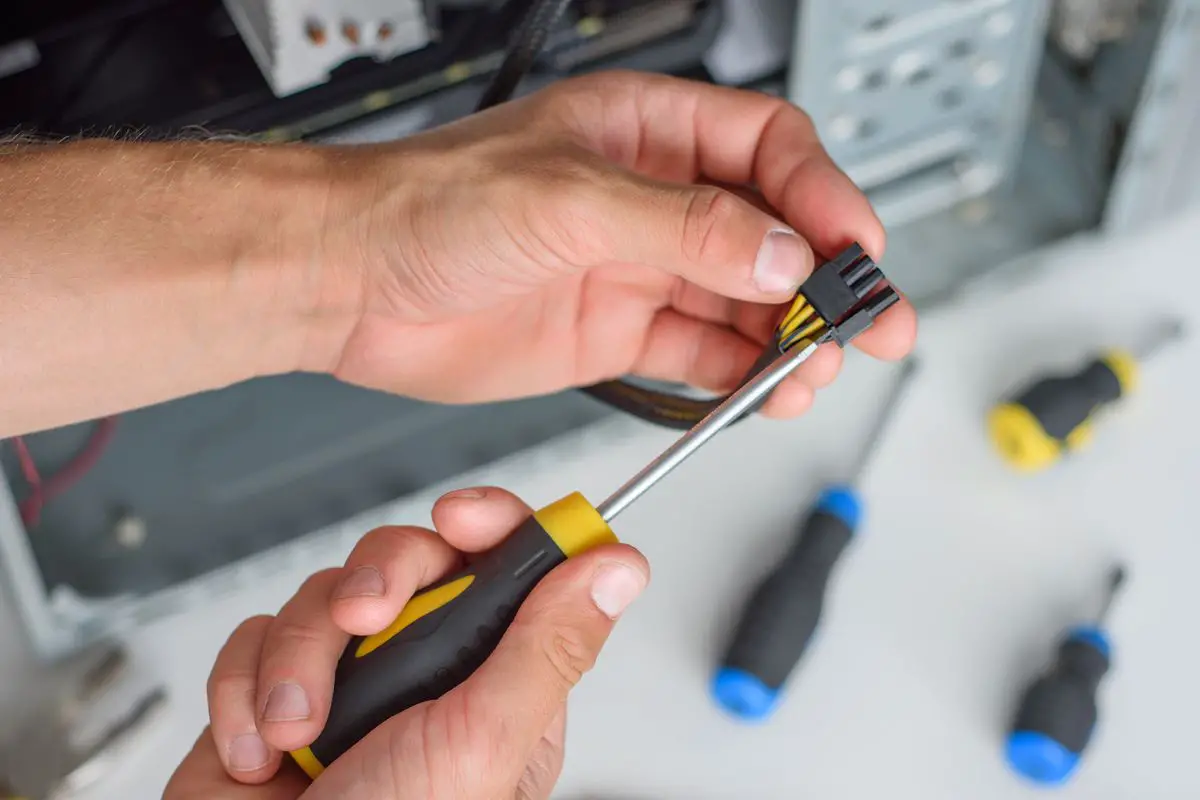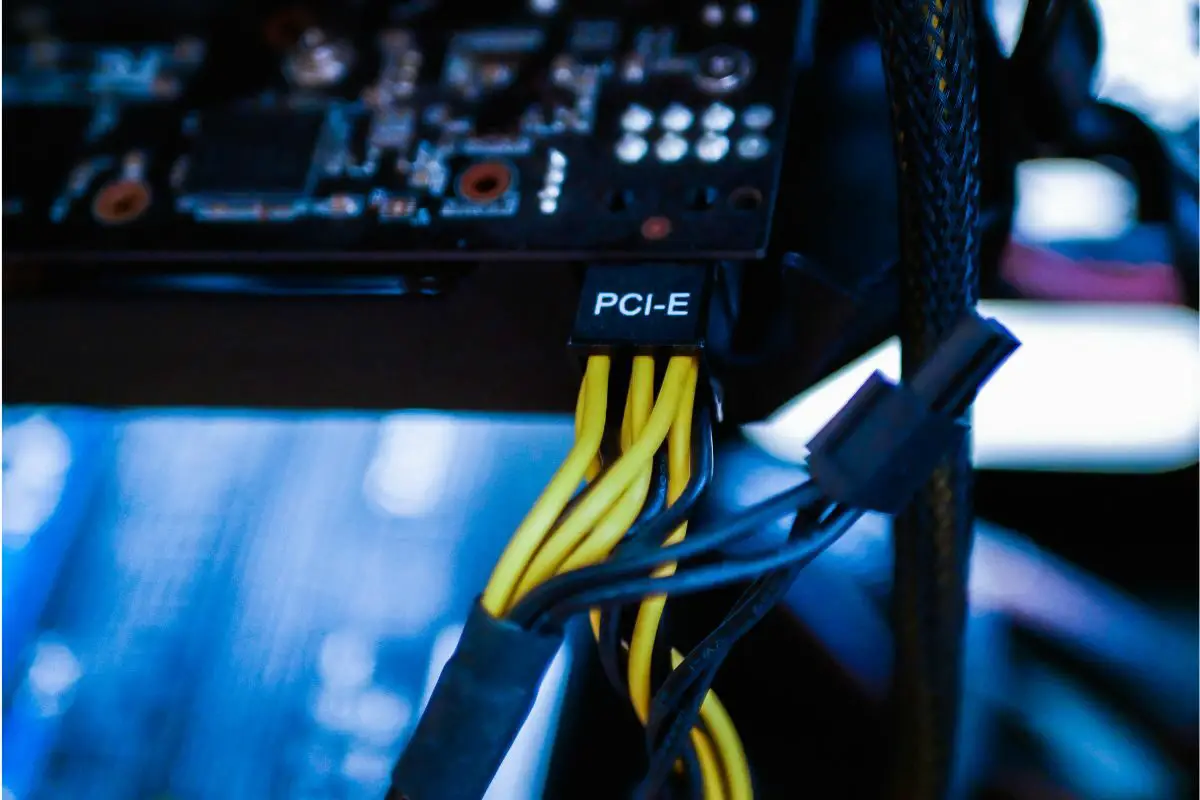
PCIE cables are special cables from the Power Supply Unit that connect to PCIE cards, like graphics cards (GPU), to send them extra power if they need it. When plugging them in-place, make sure that you're connecting them the correct way; check the clip on your power connectors, and then make sure they align with the slots on the card/GPU that you're attaching.
Regardless of if you're new to PC building or not, I can imagine how intimidating having to attach PCIe cables can be. After all, your graphics card won't work if you get it wrong. But believe me, it's really easy. The first time I did it, it only took me 10 minutes tops.
If you'd like to know how I attached them, and all kinds of other information on where PCIE cables go, and their pin connectors, you can read ahead.
Contents
If you've got your hands on a power-hungry GPU, the PCIE slots on your motherboard might not be able to power it. You'll need PCIE power cables to send in extra juice from your power supply unit to it. Just take a look at the ASUS ROG Strix NVIDIA Geforce RTX 309 GPU. It's pretty powerful, so it needs two 8-pin power cables from your PSU in order to work.
There are a couple of different PCIE cable types out there, so you can't just plug any into your graphics card. You'll have to check your GPU's product description carefully before you buy it. Like, if your graphics card has a two 8-pin requirement, you'll need a power supply unit with two 6+2 power cables.
To make sure your power supply unit can work the GPU, you'll have to find its model and then check its spec sheet online. There should be information on the PCIE cables that it has.

As there are a couple of different PCIE cables out there, I've run through how you can connect the 6+2 type into any PCIE card, like a graphics card.
Here's what you can do:
A PCI E slot is the point of connection between peripheral components, like your graphics card, solid state drive, hard drive, sound card, and video card, to your motherboard. These slots come in four different sizes - PCIe x1, x4, x8 and x16.
The number next to the slots is the number of "lanes" that they have. A lane is the physical link between the PCIE supported device and your processor. Generally, high-performance graphics cards use X16 slots. But like you saw in my guide, some of them need PCIE cables to work.
Since there are a few PCIE cable types out there, I thought it would be a good idea to run you through them.
6-Pin power cables are the smallest PCIE power cable type out there. They can provide power of around 75 W to a PCIE device.
8-pin PCIE power cables can deliver up to 150 watts. A lot of users wonder how the 6-pin cables can supply 75 watts, while the 2 extra pins in the 8-pin cables let them supply double this. But this doesn't have anything to do with the number of pins in a cable.
A 6+2 PCIE cable is essentially an 8-pin cable. It has a main 6-pin slot, with a second 2-pin slot that can be connected to it. You can either plug the 6-pin section only, or attach the 2-pin part as well. There's a lot of flexibility with this data transfer cable.
12-Pin cables were developed by NVIDIA to cater to their RTX series graphics cards. Usually, a 12-pin cable can supply up to 600 watts of power. So, they're the most suitable for very high-performance graphics cards.
Lastly, there are PCIe cables with pigtail connectors. To sum it up, they have one end connected to a power supply unit, with the other end being split into two different connectors.

Answered below are some popular questions.
If you keep getting an error telling you to check your PCIE cables, you might be dealing with a loose connection. But also, some of your ports may be broken.
I ran through some possible fixes below. Let's get to it.
Rule out whether your PCIE cables are properly connected to your graphics card. You'll need to open your PSU up to check for any loose connections.
While at it, inspect the cables and ports, and check whether they're broken. This might be because of some kind of manufacturing defect or just you being too rough when plugging a PCIE cable into place. Depending on your PSU/ GPU's warranty, you should be able to fix this for free.
You can check the video that I added earlier to properly check for loose connections.
Your power supply unit as a whole might be what's loose. No surprise, your GPU or any other PCIE card that you've connected wouldn't be able to work. There won't be any power going into it.
To fix this, you'll have to reseat your PSU in its cage.
Here's how you do this:
Even if your PSU is fitted properly, it might not be able to supply enough power to keep your graphics card working. You can use tools like Newegg's PSU calculator to figure this out. Once you've found out how much power each of your components use, you will have to check your PSU specifications to figure out whether it's able to send in this much power.
If the answer's no, you should think about getting a new power supply. You'd likely face a bunch of other problems and not just the error message, otherwise.
There are a couple of factors that can help you find the best PSU. Of course, the biggest has to be wattage requirements. But apart from it, you'll need to consider form factor, efficiency, and whether you want a modular power supply.
Form factor is basically how big your PC power supply unit is. I'd advise you to take your old PSU to the store to make sure you find power supplies that are the correct size.
Also, keep in mind efficiency. You need a unit that has an 80 Plus rating. It would be at least 80 percent efficient, so you won't have to worry about it wasting energy as heat.
And of course, consider whether you would want a modular PSU. I'd recommend going with a modular power supply, even though it would be more pricey. Your PCIE cables won't be soldered into place. So, you'll be able to remove and reattach any unused cables, which can help in the form factor department.
PCIE power cables can be plugged into graphics cards and other PCIE devices that have larger power requirements than your motherboard can support. Usually, this is the case with high-performance graphics cards, like the ASUS ROG Strix NVIDIA Geforce RTX 309, or Nvidia GeForce RTX 4090.
As there are a couple of different PCIE cables out there, you'll need to make sure that you have the correct type, like your cable might need a 6+2 pin cable, while you only have a 4 pin one. I discussed how you can figure this out along with some other useful information in my article.
Hopefully, you found all of these points useful and now have a good understanding of where PCIE cables go and how they work.
